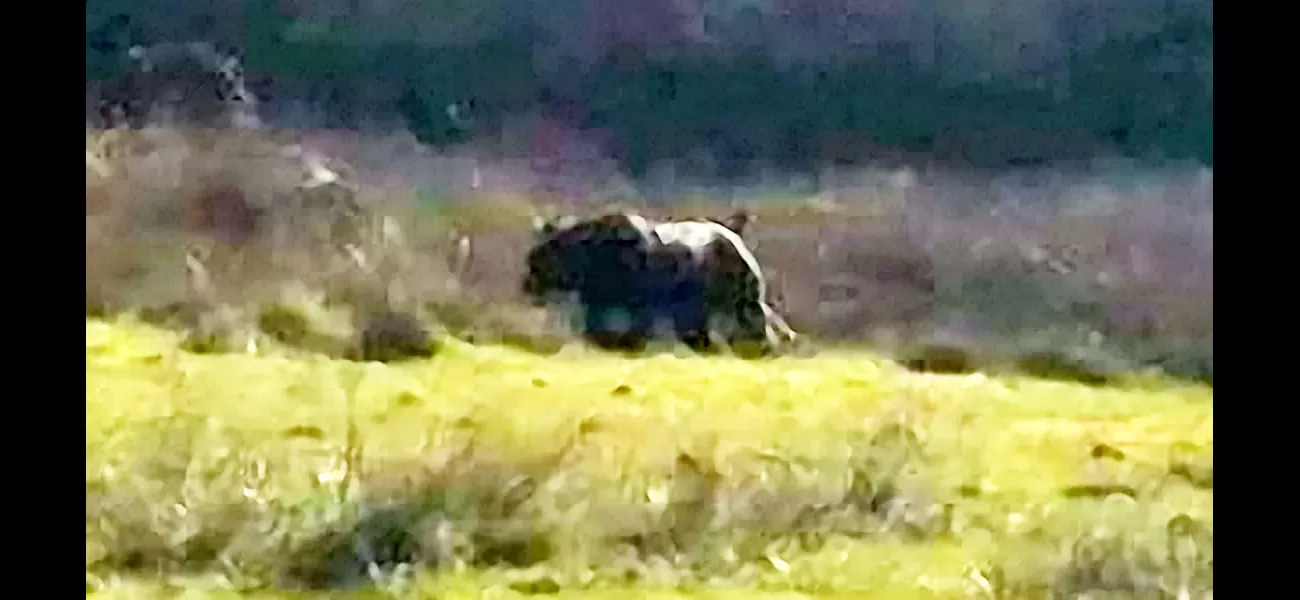British countryside sightings may not actually be big cats, according to hunters.
Hidden predators are reportedly present in the British countryside.
June 8th 2024.

Recently, a photo surfaced online showing what appeared to be a big cat roaming through the grass in Somerset. This, however, is not a rare occurrence in the British countryside. In fact, it has been linked to the dumping of "trophy" pets by two experienced investigators.
Many members of the public have reported seeing and even capturing photos and videos of non-native creatures in the wild. However, despite these sightings, concrete evidence to prove their existence remains elusive. One of the latest sightings was captured on trail cameras set up in Gloucestershire, showing what seemed to be a large cat sniffing the ground in the woodland. Rick Minter, host of the Big Cat Conversations podcast, revealed that such reports are not uncommon.
According to Minter, people all over Britain have reported seeing the same three types of large cats - black leopards, sandy-brown mountain lions, and lynx, which used to be Britain's native cat. These creatures are known for their versatility and stealth, making it difficult for people to mistake them for any other animal. In fact, their presence is also felt by dogs and horses, making it clear that these are not just mistaken sightings.
But despite the numerous sightings and reported encounters, obtaining clear evidence of their existence has been a challenge. Minter, along with others, has been on the hunt for proof such as close-up photos from camera traps, toothmarks on bones, or DNA samples. However, these have been hard to come by, as private landowners and stalkers who have managed to film these creatures prefer to keep their findings to themselves.
Minter also emphasized that the cats seem to stick to natural prey and rarely go after sheep, making them a valuable part of the ecosystem. In fact, recent DNA results from Gloucestershire and Cumbria have backed the theory of black leopards roaming in the area. While some skeptics have suggested that the DNA may have been planted, Minter, who is involved in coordinating DNA samples for universities, rejects this claim, stating that there is no reason for them to cheat or betray the students involved.
One of the most recent sightings was reported by Andy and Claire Rule, who have been researching big cats since 2012. The couple captured photos of a large black cat on three cameras set up in a half-mile area near Nympsfield. This was followed by a report of DNA found on a barbed wire fence, which was a 99% match to a leopard. This discovery only added to the ongoing debate about the existence of these big cats in the British countryside.
This is not the first time that such sightings have caused a stir. In fact, the mysterious "Beast of Bodmin" has been a topic of discussion for over 30 years, with reports of livestock being mutilated in Cornwall. In 1995, the government launched an investigation into the matter but found no concrete evidence to prove the existence of this creature, which was described as a black panther. However, the possibility of its presence was not completely ruled out.
In 2016, a zookeeper claimed that a pack of pumas had been released from Dartmoor Zoo in the 1980s and have been on the loose ever since. Sightings of the beast - whether real or not - have continued, and it has even become a part of Cornwall's tourist guide. Minter traces the origin of these big cats back to a time when owning exotic pets was not strictly regulated. In the 1960s and 1970s, big cats like leopards, pumas, and panthers were popular fashion accessories and were even sold at Harrods' pet shop. However, changes in the law now require owners to obtain licenses for these animals. Despite this, there are still some owners who choose to release their pets into the countryside rather than giving them up or keeping them in proper facilities.
The debate about the existence of big cats in the British countryside is ongoing, with numerous sightings and reported encounters. While some skeptics may dismiss these claims, the search for concrete evidence continues, and the mystery of these majestic creatures roaming freely in the wild remains unsolved.
There has been a lot of buzz lately about the sightings of big cats in the British countryside. Some people have even captured photos and videos of these non-native creatures roaming in the wild. However, it's been difficult to obtain concrete evidence to prove their existence.
Just recently, a trail camera in Gloucestershire captured what seemed to be a large cat sniffing the ground in the woods. Rick Minter, host of the Big Cat Conversations podcast, explains that this type of sighting is not uncommon. People all over Britain have reported seeing three types of large cats: black leopards, sandy-brown mountain lions, and lynxes (which used to be native to Britain). These cats are skilled hunters, versatile, and incredibly stealthy. And it's not just humans who have encountered them – even dogs and horses have reacted to their presence. So, these sightings are not simply a case of mistaken identity.
But while there have been numerous sightings, there is still a lack of solid evidence to confirm their existence. Rick and other investigators are on the hunt for things like close-up photos, tooth marks on bones, and DNA samples to prove the presence of these big cats in the UK. However, there are some private landowners and stalkers who have managed to capture footage of these cats, but they prefer to keep it to themselves and not draw too much attention to their land. Most of them have come to appreciate the role these cats play in the ecosystem, quietly culling deer, rabbits, and pigeons.
Some skeptics have suggested that the DNA samples found in places like Gloucestershire and Cumbria are planted. But Rick, who helps coordinate samples for DNA labs at universities, points out that there would be no reason to fabricate evidence and betray the students involved. The recent sighting of a large, black animal in Gloucestershire, along with the discovery of a panther-like creature in Staffordshire, have only added to the mystery and intrigue surrounding these big cats.
The search for evidence of big cats in the UK has been going on for years, with some of the earliest sightings dating back to the 1960s and 70s. Back then, it was not uncommon for exotic pets, including big cats, to be sold in places like Harrods' pet shop. However, changes in the law now require owners to obtain licenses for these animals. Some owners, unwilling to go through the hassle and expense of obtaining a license, have released their pets into the countryside. This is where the theory of dumped "trophy" pets comes in, as many of these big cats are believed to have originated from private owners.
One of the most famous cases of a big cat sighting in the UK is the Beast of Bodmin. For over 30 years, this mysterious creature was said to have roamed Cornwall, mutilating livestock and causing fear among the locals. It even gained enough attention to warrant a government investigation in 1995, which concluded that there was no conclusive evidence to prove or disprove its existence. However, in 2016, a zookeeper claimed that a pack of pumas had been released from Dartmoor Zoo in the 1980s and had been roaming free ever since. Sightings of the Beast of Bodmin have continued, and it has even become a popular tourist attraction in Cornwall.
So, while there is still no definitive proof of the existence of big cats in the British countryside, the sightings and stories continue to intrigue us. Whether these cats are truly roaming free in the wild or are simply the result of dumped pets, one thing is for sure – the mystery surrounding them is here to stay.
Many members of the public have reported seeing and even capturing photos and videos of non-native creatures in the wild. However, despite these sightings, concrete evidence to prove their existence remains elusive. One of the latest sightings was captured on trail cameras set up in Gloucestershire, showing what seemed to be a large cat sniffing the ground in the woodland. Rick Minter, host of the Big Cat Conversations podcast, revealed that such reports are not uncommon.
According to Minter, people all over Britain have reported seeing the same three types of large cats - black leopards, sandy-brown mountain lions, and lynx, which used to be Britain's native cat. These creatures are known for their versatility and stealth, making it difficult for people to mistake them for any other animal. In fact, their presence is also felt by dogs and horses, making it clear that these are not just mistaken sightings.
But despite the numerous sightings and reported encounters, obtaining clear evidence of their existence has been a challenge. Minter, along with others, has been on the hunt for proof such as close-up photos from camera traps, toothmarks on bones, or DNA samples. However, these have been hard to come by, as private landowners and stalkers who have managed to film these creatures prefer to keep their findings to themselves.
Minter also emphasized that the cats seem to stick to natural prey and rarely go after sheep, making them a valuable part of the ecosystem. In fact, recent DNA results from Gloucestershire and Cumbria have backed the theory of black leopards roaming in the area. While some skeptics have suggested that the DNA may have been planted, Minter, who is involved in coordinating DNA samples for universities, rejects this claim, stating that there is no reason for them to cheat or betray the students involved.
One of the most recent sightings was reported by Andy and Claire Rule, who have been researching big cats since 2012. The couple captured photos of a large black cat on three cameras set up in a half-mile area near Nympsfield. This was followed by a report of DNA found on a barbed wire fence, which was a 99% match to a leopard. This discovery only added to the ongoing debate about the existence of these big cats in the British countryside.
This is not the first time that such sightings have caused a stir. In fact, the mysterious "Beast of Bodmin" has been a topic of discussion for over 30 years, with reports of livestock being mutilated in Cornwall. In 1995, the government launched an investigation into the matter but found no concrete evidence to prove the existence of this creature, which was described as a black panther. However, the possibility of its presence was not completely ruled out.
In 2016, a zookeeper claimed that a pack of pumas had been released from Dartmoor Zoo in the 1980s and have been on the loose ever since. Sightings of the beast - whether real or not - have continued, and it has even become a part of Cornwall's tourist guide. Minter traces the origin of these big cats back to a time when owning exotic pets was not strictly regulated. In the 1960s and 1970s, big cats like leopards, pumas, and panthers were popular fashion accessories and were even sold at Harrods' pet shop. However, changes in the law now require owners to obtain licenses for these animals. Despite this, there are still some owners who choose to release their pets into the countryside rather than giving them up or keeping them in proper facilities.
The debate about the existence of big cats in the British countryside is ongoing, with numerous sightings and reported encounters. While some skeptics may dismiss these claims, the search for concrete evidence continues, and the mystery of these majestic creatures roaming freely in the wild remains unsolved.
There has been a lot of buzz lately about the sightings of big cats in the British countryside. Some people have even captured photos and videos of these non-native creatures roaming in the wild. However, it's been difficult to obtain concrete evidence to prove their existence.
Just recently, a trail camera in Gloucestershire captured what seemed to be a large cat sniffing the ground in the woods. Rick Minter, host of the Big Cat Conversations podcast, explains that this type of sighting is not uncommon. People all over Britain have reported seeing three types of large cats: black leopards, sandy-brown mountain lions, and lynxes (which used to be native to Britain). These cats are skilled hunters, versatile, and incredibly stealthy. And it's not just humans who have encountered them – even dogs and horses have reacted to their presence. So, these sightings are not simply a case of mistaken identity.
But while there have been numerous sightings, there is still a lack of solid evidence to confirm their existence. Rick and other investigators are on the hunt for things like close-up photos, tooth marks on bones, and DNA samples to prove the presence of these big cats in the UK. However, there are some private landowners and stalkers who have managed to capture footage of these cats, but they prefer to keep it to themselves and not draw too much attention to their land. Most of them have come to appreciate the role these cats play in the ecosystem, quietly culling deer, rabbits, and pigeons.
Some skeptics have suggested that the DNA samples found in places like Gloucestershire and Cumbria are planted. But Rick, who helps coordinate samples for DNA labs at universities, points out that there would be no reason to fabricate evidence and betray the students involved. The recent sighting of a large, black animal in Gloucestershire, along with the discovery of a panther-like creature in Staffordshire, have only added to the mystery and intrigue surrounding these big cats.
The search for evidence of big cats in the UK has been going on for years, with some of the earliest sightings dating back to the 1960s and 70s. Back then, it was not uncommon for exotic pets, including big cats, to be sold in places like Harrods' pet shop. However, changes in the law now require owners to obtain licenses for these animals. Some owners, unwilling to go through the hassle and expense of obtaining a license, have released their pets into the countryside. This is where the theory of dumped "trophy" pets comes in, as many of these big cats are believed to have originated from private owners.
One of the most famous cases of a big cat sighting in the UK is the Beast of Bodmin. For over 30 years, this mysterious creature was said to have roamed Cornwall, mutilating livestock and causing fear among the locals. It even gained enough attention to warrant a government investigation in 1995, which concluded that there was no conclusive evidence to prove or disprove its existence. However, in 2016, a zookeeper claimed that a pack of pumas had been released from Dartmoor Zoo in the 1980s and had been roaming free ever since. Sightings of the Beast of Bodmin have continued, and it has even become a popular tourist attraction in Cornwall.
So, while there is still no definitive proof of the existence of big cats in the British countryside, the sightings and stories continue to intrigue us. Whether these cats are truly roaming free in the wild or are simply the result of dumped pets, one thing is for sure – the mystery surrounding them is here to stay.
[This article has been trending online recently and has been generated with AI. Your feed is customized.]
[Generative AI is experimental.]
0
0
Submit Comment





